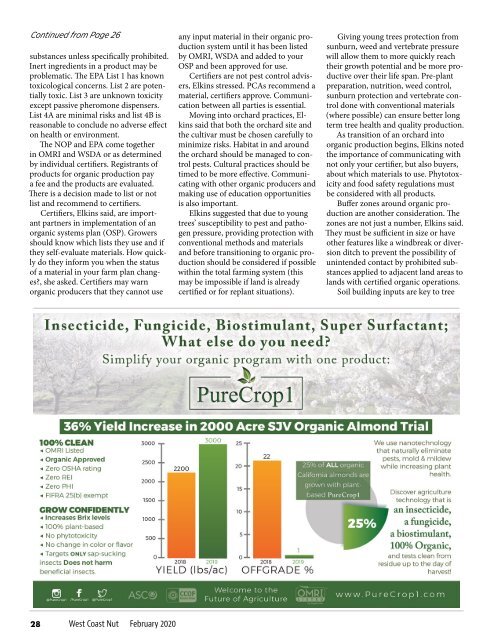Create successful ePaper yourself
Turn your PDF publications into a flip-book with our unique Google optimized e-Paper software.
Continued from Page 26<br />
substances unless specifically prohibited.<br />
Inert ingredients in a product may be<br />
problematic. The EPA List 1 has known<br />
toxicological concerns. List 2 are potentially<br />
toxic. List 3 are unknown toxicity<br />
except passive pheromone dispensers.<br />
List 4A are minimal risks and list 4B is<br />
reasonable to conclude no adverse effect<br />
on health or environment.<br />
The NOP and EPA come together<br />
in OMRI and WSDA or as determined<br />
by individual certifiers. Registrants of<br />
products for organic production pay<br />
a fee and the products are evaluated.<br />
There is a decision made to list or not<br />
list and recommend to certifiers.<br />
Certifiers, Elkins said, are important<br />
partners in implementation of an<br />
organic systems plan (OSP). Growers<br />
should know which lists they use and if<br />
they self-evaluate materials. How quickly<br />
do they inform you when the status<br />
of a material in your farm plan changes?,<br />
she asked. Certifiers may warn<br />
organic producers that they cannot use<br />
any input material in their organic production<br />
system until it has been listed<br />
by OMRI, WSDA and added to your<br />
OSP and been approved for use.<br />
Certifiers are not pest control advisers,<br />
Elkins stressed. PCAs recommend a<br />
material, certifiers approve. Communication<br />
between all parties is essential.<br />
Moving into orchard practices, Elkins<br />
said that both the orchard site and<br />
the cultivar must be chosen carefully to<br />
minimize risks. Habitat in and around<br />
the orchard should be managed to control<br />
pests. Cultural practices should be<br />
timed to be more effective. Communicating<br />
with other organic producers and<br />
making use of education opportunities<br />
is also important.<br />
Elkins suggested that due to young<br />
trees’ susceptibility to pest and pathogen<br />
pressure, providing protection with<br />
conventional methods and materials<br />
and before transitioning to organic production<br />
should be considered if possible<br />
within the total farming system (this<br />
may be impossible if land is already<br />
certified or for replant situations).<br />
Giving young trees protection from<br />
sunburn, weed and vertebrate pressure<br />
will allow them to more quickly reach<br />
their growth potential and be more productive<br />
over their life span. Pre-plant<br />
preparation, nutrition, weed control,<br />
sunburn protection and vertebrate control<br />
done with conventional materials<br />
(where possible) can ensure better long<br />
term tree health and quality production.<br />
As transition of an orchard into<br />
organic production begins, Elkins noted<br />
the importance of communicating with<br />
not only your certifier, but also buyers,<br />
about which materials to use. Phytotoxicity<br />
and food safety regulations must<br />
be considered with all products.<br />
Buffer zones around organic production<br />
are another consideration. The<br />
zones are not just a number, Elkins said.<br />
They must be sufficient in size or have<br />
other features like a windbreak or diversion<br />
ditch to prevent the possibility of<br />
unintended contact by prohibited substances<br />
applied to adjacent land areas to<br />
lands with certified organic operations.<br />
Soil building inputs are key to tree<br />
28<br />
West Coast Nut <strong>February</strong> <strong>2020</strong>


















